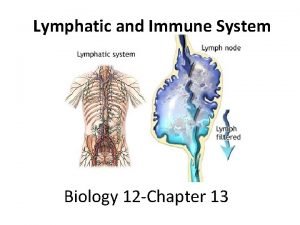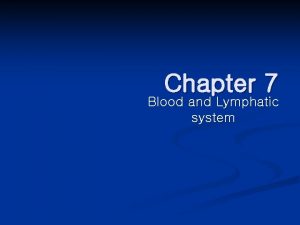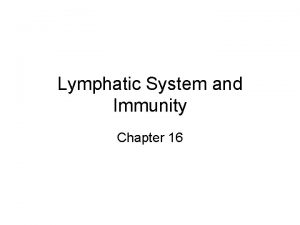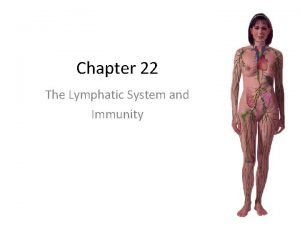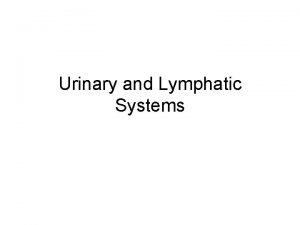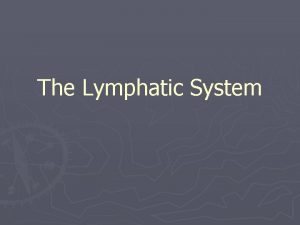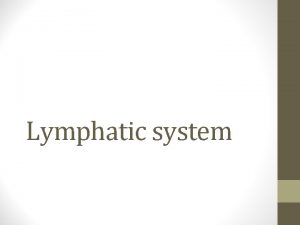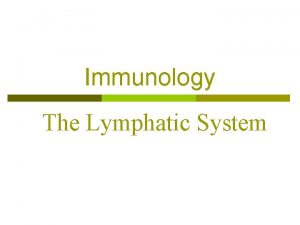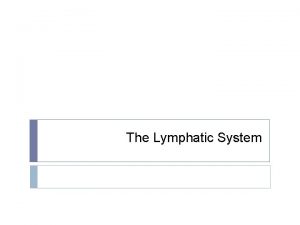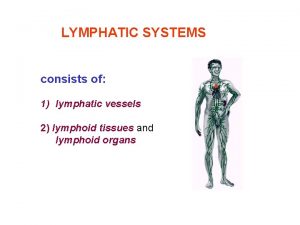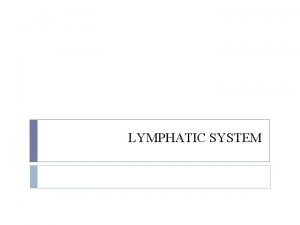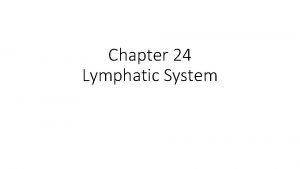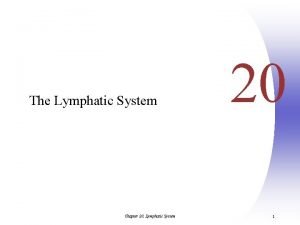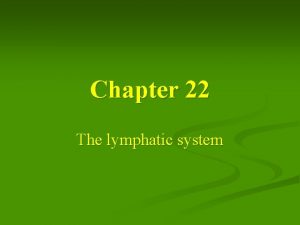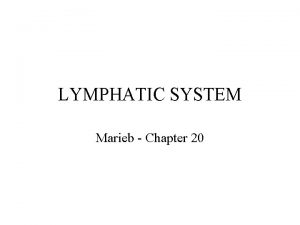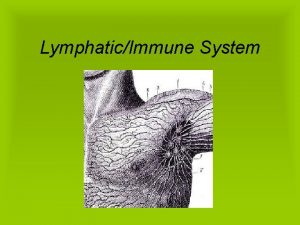LYMPHATIC SYSTEM CHAPTER 12 LYMPHATIC SYSTEM CONSISTS OF


















- Slides: 18

LYMPHATIC SYSTEM CHAPTER 12

LYMPHATIC SYSTEM �CONSISTS OF 2 PARTS 1. LYMPHATIC VESSELS- transport fluids that have escaped the cardiovascular system called LYMPH 2. LYMPHATIC ORGANS- (lymph nodes)- filter the fluid and kill off invaders with lymphocytes

Lymphatic Vessels Very similar to veins with lymph capillaries becoming successively larger and eventually called LYMPHATIC COLLECTING DUCTS. Have valves very similar to veins that help to move lymph RIGHT LYMPHATIC DUCT – collects lymph from the right arm and right thorax and right head- drains into the subclavian vein THORACIC DUCT- collects lymph from the rest of body – drains into the sub clavian vein

LYMPH NODES -KIDNEY SHAPED -ABOUT 1 INCH LONG -about 1000 found in the body -contains large amounts of lymphocytes –B cells and T cells -FOUND IN CLUSTERS IN 3 MAJOR REGIONS 1. AXILLARY– (armpit) 2. CERVICAL- (side of neck) 3. INGUINAL- (groin)

LYMPH ORGANS SPLEEN THYMUS TONSILS PEYER’S PATCHES

SPLEEN Located on the left side and curls around the stomach Filters the blood of bacteria, viruses and other debris Breaks down worn out RED BLOOD CELLS so hemoglobin can be reused. Storage site of blood. Produce Lymphocytes

THYMUS �Produces hormones- thymosin that programs lymphocytes �Located low in the throat �More active in youth

TONSILS Lymphatic tissue located in the pharynx. Trap bacteria entering the pharynx May become sore and swollen called --- TONSILITIS

PEYER’S PATCHES “tonsils” of the small intestine Capture bacteria that are found in the digestive system. MUCOSA-ASSOCIATED LYMPHATIC TISSUE(MALT) consists of tonsils and Peyer’s patches which protect the respiratory and digestive tracts from never-ending invasion

NON SPECIFIC DEFENSE SYSTEMS SKINSWEAT contains a low p. H level preventing bacterial growth SEBUM- contains chemicals toxic to bacteria VAGINAL SECRETIONS- highly acidic

NON SPECIFIC DEFENSE SYSTEM �STOMACH- hydrochloric acid is highly acidic �SALIVA- contains lysozomes- enzyme that kills bacteria �MUCUS- traps organisms from entering the digestive and respiratory systems

SPECIFIC BODY DEFENSES �Commonly called the IMMUNE SYSTEM or IMMUNE RESPONSE � 3 Characteristics � 1. It is ANTIGEN specific � 2. It is SYSTEMIC- (full body) � 3. It has a MEMORY- (T cells)

ANTIGEN �Any substance capable of setting off an immune response. �Almost all things are ANTIGENIC (including our own cells) but our body had learn to identify our cells and these SELF-ANTIGENS do not trigger an immune response in us.

CELLS OF THE IMMUNE SYSTEM �LYMPHOCYTES- B CELLS- lymphocytes that mature in the bone marrow-produce antibodies and T CELLS- lymphocytes that mature in the thymus - do not produce antibodies– but do release chemicals to spend up phagocytosis by MACROPHAGES �MACROPHAGES- large cells that engulf foreign particles and present the antigen to

IMMUNE RESPONSE

AUTOIMMUNE DISEASES MULTIPLE SCLEROSIS MYASTHENIA GRAVIS GRAVES DISEASE


 Lymphatic collecting vessels
Lymphatic collecting vessels Lymphatic system consists of
Lymphatic system consists of Chapter 12 the lymphatic system and body defenses
Chapter 12 the lymphatic system and body defenses Dho7
Dho7 Chapter 13 lymphatic system and immunity
Chapter 13 lymphatic system and immunity Chapter 7:9 lymphatic system
Chapter 7:9 lymphatic system Chapter 12 the lymphatic system and body defenses
Chapter 12 the lymphatic system and body defenses Chapter 12 the lymphatic system and body defenses
Chapter 12 the lymphatic system and body defenses Chapter 16 lymphatic system and immunity
Chapter 16 lymphatic system and immunity Chapter 7:9 lymphatic system
Chapter 7:9 lymphatic system Lymphatic system is composed of
Lymphatic system is composed of Chapter 10 lymphatic system diseases and disorders
Chapter 10 lymphatic system diseases and disorders Lymphatic system vs endocrine system
Lymphatic system vs endocrine system Spleen function
Spleen function Chapter 24 the immune and lymphatic systems and cancer
Chapter 24 the immune and lymphatic systems and cancer Chapter 24 the immune and lymphatic systems and cancer
Chapter 24 the immune and lymphatic systems and cancer Great saphenous
Great saphenous What are the function of lymphatic system
What are the function of lymphatic system Functions of the lymphatic system
Functions of the lymphatic system




